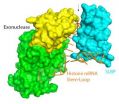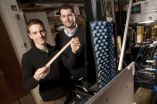(Press-News.org) The dwindling reserves of fuelwood in Africa have been illuminated in a new study published today, which shows a bleak outlook for supplies across savannas in South Africa.
Presenting their findings in IOP Publishing's journal Environmental Research Letters, researchers have found that at current consumption levels in the communal areas of Lowveld, South Africa, reserves of fuelwood could be totally exhausted within 13 years.
The consequences are significant, with around half of the 2.4 million rural households in the country using wood as their primary fuel source, burning between four and seven million tonnes per year.
Consumption of fuelwood is greater across the rest of sub-Saharan Africa, which includes countries significantly less developed than South Africa – around 80 per cent of households rely on fuelwood as their primary energy source.
The researchers measured the amount of biomass currently covering the study areas using the Carnegie Airborne Observatory (CAO) – an aircraft loaded with state-of-the-art imaging systems (funded by the Andrew Mellon Foundation).
The CAO was flown at an altitude of 2000 metres across 30 000 hectares of land and a light detection and ranging (LiDAR) system was used to calculate tree height by firing millions of laser pulses down to the ground and measuring the time it takes for the light to return to the aircraft.
The study area included Kruger National Park, Sabi Sand Game Reserve and communal areas in the Bushbuck Ridge municipality. The result was a set of tree height maps from which biomass maps were generated.
The researchers selected the village of Justicia as a model for calculating how reserves of fuelwood could be reduced under different consumption scenarios. They found that under current consumption rates, the fuelwood around this area would be totally exhausted within 13 years; however, locals could stop collecting at least two to three years in advance of this if the quality and density of fuelwood becomes too low.
They also showed that households using fuelwood would need to be reduced by 15 per cent a year for eight years, until only 20 per cent of total households are using it, before biomass stabilises to a sustainable level.
"Despite significant electrification of rural households in South Africa, large amounts of fuelwood are still being extracted from savannah woodlands," said lead-author of the letter Konrad Wessels.
"Rural households need to reduce fuelwood use in favour of other energy alternatives. Currently the only viable alternative is electric stoves, but the switch to electric stoves has been slow, apparently due to the cost of stoves and electricity, as well as cultural preferences. Furthermore, since unemployment is high, there is ample labour to collect free fuelwood, even as it becomes scarce."
"The use of alternative sources of energy for cooking should be promoted to balance out the current unsustainable rate of fuel wood extraction; however, it will still require interventions aimed at general poverty reduction, and culturally acceptable energy alternatives."
###From Friday 18 January this paper can be downloaded.
Notes to Editors
Contact
1. For further information, a full draft of the journal paper or contact with one of the researchers, contact IOP Press Officer, Michael Bishop:
Tel: 0117 930 1032
E-mail: Michael.bishop@iop.org
Unsustainable fuelwood extraction from South African savannas
2. The published version of the paper 'Unsustainable fuelwood extraction from South African savannas' (K J Wessels et al 2013 Environ. Res. Lett. 8 014007) will be freely available online from Friday 18 January.
Environmental Research Letters
3. Environmental Research Letters is an open access journal that covers all of environmental science, providing a coherent and integrated approach including research articles, perspectives and editorials.
IOP Publishing
4. IOP Publishing provides publications through which leading-edge scientific research is distributed worldwide. IOP Publishing is central to the Institute of Physics (IOP), a not-for-profit society. Any financial surplus earned by IOP Publishing goes to support science through the activities of IOP.Beyond our traditional journals programme, we make high-value scientific information easily accessible through an ever-evolving portfolio of community websites, magazines, conference proceedings and a multitude of electronic services. Focused on making the most of new technologies, we're continually improving our electronic interfaces to make it easier for researchers to find exactly what they need, when they need it, in the format that suits them best. Go to http://ioppublishing.org/.
The Institute of Physics
5. The Institute of Physics is a leading scientific society. We are a charitable organisation with a worldwide membership of more than 45,000, working together to advance physics education, research and application. We engage with policymakers and the general public to develop awareness and understanding of the value of physics and, through IOP Publishing, we are world leaders in professional scientific communications. Go to www.iop.org.
Savanna study highlights African fuelwood crisis
2013-01-18
ELSE PRESS RELEASES FROM THIS DATE:
Molecular twist helps regulate the cellular message to make histone proteins
2013-01-18
(Embargoed) CHAPEL HILL, N.C. – Histone proteins are the proteins that package DNA into chromosomes. Every time the cell replicates its DNA it must make large amounts of newly made histones to organize DNA within the nucleus.
An imbalance in the production of DNA and histones is usually lethal for the cell, which is why the levels of the messenger RNA (mRNA) encoding the histone proteins must be tightly controlled to ensure the proper amounts of histones (not too many and not too few) are made.
In a collaborative effort published online in the January 18, 2013 issue ...
Inadequate food facilities in NC migrant camps could cause illness
2013-01-18
WINSTON-SALEM, N.C. – Jan. 17, 2013 – Farmworkers are at potential risk from food and waterborne illnesses because of the condition of cooking and eating facilities available to them, according to a new study from Wake Forest Baptist Medical Center.
Researchers from Wake Forest Baptist are the first to evaluate cooking and eating facilities in migrant farmworker camps to compare against established housing regulations. They found that the facilities fail to comply with regulations in a substantial number of camps. The study, which appears online today in the January issue ...
A global approach to monitoring biodiversity loss
2013-01-18
In contrast to climate change, there is no coordinated global system in place for measuring and reporting on biodiversity change or loss. An international team of biologists is now addressing this gap.
In Science today, 30 researchers led by Henrique Miguel Pereira, from the Centre for Environmental Biology of the University of Lisbon, proposed a global biodiversity monitoring system based on a set of essential variables.
By determining the most essential measurements to accurately and usefully report on biodiversity loss, known as essential biodiversity variables (EBVs), ...
Weight loss helps to oust worms
2013-01-18
Scientists from The University of Manchester have discovered that weight loss plays an important role in the body's response to fighting off intestinal worms.
The findings have been published in the journal PLOS Pathogens and show that the immune system hijacks the natural feeding pathways causing weight loss. This then drives the defense mechanisms down the correct pathway to expel the worms.
Nearly one quarter of the world's population is infected with gastrointestinal parasites. These prevalent infections often result in a period of reduced appetite resulting in ...
Sniffing immune cells
2013-01-18
This press release is available in German.
Immune cells constantly patrol our body to check for foreign invaders, such as bacteria or viruses. To do so they leave the blood stream, actively crawl through tissues and finally re-enter the circulation via lymphatic vessels. Research from the laboratory of Michael Sixt elucidates how the cells are guided through tissues like the skin. It is thought that cells either sense their environment by 'touching' or 'smelling': They adhere to structural molecules like connective tissue proteins using adhesion receptors. Or ...
Separating gases using a rigid polymer sieve
2013-01-18
Gas separation is crucial for many industrial processes including obtaining nitrogen or oxygen from air and purifying natural gas or hydrogen. Currently, the most energy efficient method for separating gases involves polymer membranes, however, most polymers either let gases pass through slowly (i.e. have low permeability) or are not selective towards one gas over another. Gas separation would be cheaper and use less energy if polymer membranes could be made both highly permeable and selective.
A team from the University's School of Chemistry reports in the journal Science ...
GI tract bacteria may protect against autoimmune disease
2013-01-18
This press release is available in German.
Toronto -- Early life exposure to normal bacteria of the GI tract (gut microbes) protects against autoimmune disease in mice, according to research published on-line in the January 17 edition of Science. The study may also have uncovered reasons why females are at greater risk of autoimmune diseases such as multiple sclerosis, rheumatoid arthritis, and lupus compared to males.
Researchers from The Hospital for Sick Children (SickKids) found that when female mice at high risk of autoimmune (type 1) diabetes were exposed ...
U Alberta researchers move Barkhausen Effect forward
2013-01-18
(Edmonton) Almost 100 years after the initial discovery, a team of scientists at the University of Alberta and the National Institute for Nanotechnology in Edmonton have harnessed the Barkhausen Effect as a new kind of high-resolution microscopy for the insides of magnetic materials.
The researchers say the technique has the potential to provide critical information as a rapid prototyper for magnetic computational devices that expand the role of magnetism within computers.
In 1919, Barkhausen discovered the first evidence of magnetic domains (patterns in how the directions ...
Doubling down on energy efficiency
2013-01-18
Spending on energy efficiency programs funded by electric and natural gas utility customers will double by 2025 to about $9.5 billion per year, according to projections published today by researchers at Lawrence Berkeley National Laboratory (Berkeley Lab).
These funds, which come from a charge on utility bills, historically constitute the nation's largest source of spending on programs to foster the adoption of more efficient products and buildings. According to the Berkeley Lab report, energy efficiency programs funded by utility customers are projected to continue ...
Novel sensor provides bigger picture
2013-01-18
DURHAM, N.C. – Duke University engineers have developed a novel sensor that is more efficient, versatile and cheaper for potential use in such applications as airport security scanners and collision avoidance systems for aircraft, cars or maritime vessels.
The researchers fabricated a unique material, known as a metamaterial, that acts as a lens to image scenes using fewer components than conventional detectors. Because of the properties of this man-made material, much of the additional equipment needed for conventional detector systems – like lenses, mechanical positioners ...




